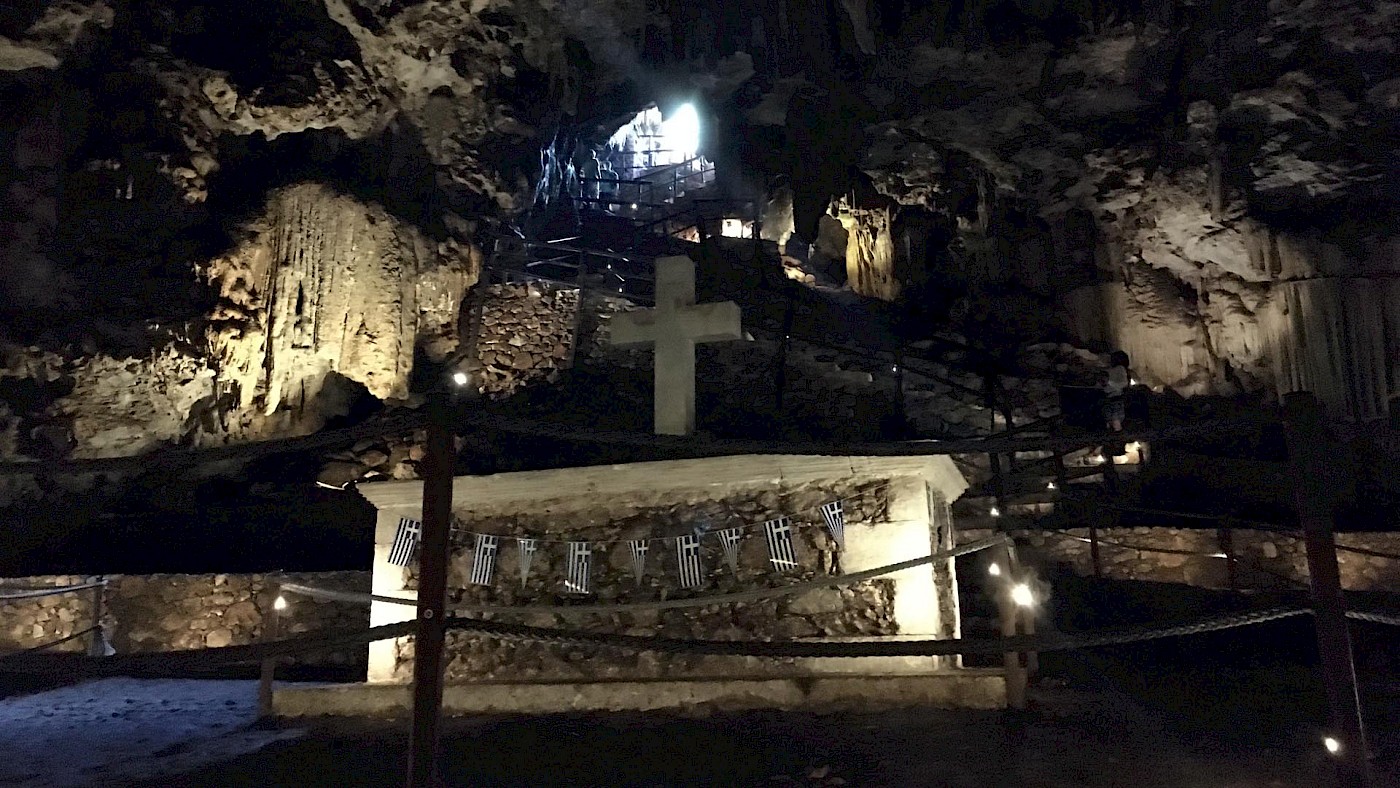About half an hour’s drive east of Rethymno, in the southern part of Mount Kouloukonas in Crete, lies a cave called Gerontospilios (“Old Cave”). It is more commonly referred to as Melidoni Cave in English, named after the nearby village of Melidoni. The village itself is named after the renowned Cretan resistance fighter, Antonios Melidonis, who was born there.
We visited the site last summer. Due to the coronavirus, two parts of the cave – the so-called Raulin and Pashley Rooms – were closed to the public. Masks were mandatory; gloves were recommended. We wore both, just to be sure. Only a limited number of people were allowed into the cave and you only had 20 minutes to visit the main chamber. (Unlike some countries, Greece takes the pandemic very seriously.)
To enter the cave, you have to walk a short distance from the ticket booth (and a nearby small chapel), across an uneven stretch of terrain: a doline of around 25 metres in diametre that was formed when part of the cave collapsed. A low natural arch a little further along forms the entrance of the cave. Once inside, stairs take you to the bottom of the main chamber (“Room of the Heroes”), where there is a path that leads you round in a circle. In the centre is a flat area with a large, stone ossuary topped with a cross.
In 1824, during the Turkish occupation, 370 civilians from the village, including women and children, along with 30 Cretan resistance fighters, sought refuge in the cave. The Turks were unable to dislodge them and, in the end, lit a fire near the entrance, which they blocked off, and channelled the smoke into the cave. As a result, the refugees choked to death. Their bones were collected and put inside the ossuary that was built to commemorate their sacrifice.

The cave has been frequented by people seemingly for as long as there have been humans on Crete. According to the site’s informative brochure, illegal excavations revealed Neolithic tools in 1928 and a bronze double-axe in 1940 (now in the Iraklion Museum). More systematic excavations were conducted in 1954 by P. Faure, who unearthed pottery dated to the Late Minoan, Geometric, and Roman periods.
Rescue excavations started in 1987 when the site was about to be turned into a tourist destination. Various layers of charcoal were unearthed in the so-called Raulin Room, a recess accessible from the “Room of Heroes”, which have been dated to the Late Minoan period, under which various pots were found dated to the Neopalatial period (on Minoan chronology, check this article). Along with finds elsewhere in the cave, it is clear that the site was used as a place of worship and/or ritual in the second millennium BC. Earlier, it may have been used as a dwelling.
By the Archaic period, a large phallus-shaped stalagmite inside the cave may have been a special object of worship. Various figurines of naked and dressed females, all dated to ca. 680-600 BC, were found at its foot. Worship here may have been interrupted until the Hellenistic period, when figurines are once again dedicated here. Then, from the Late Roman era, excavators have unearthed lamps and pins.
Inscriptions near the entrance of the cave indicate that it was by then associated with the messenger god Mercury (Greek: Hermes). Other inscriptions are hidden behind fallen rock; an investigation in 1998 in search for more revealed the presence of a makeshift lime-kiln near the entrance. Such a kiln is used for the calcination of limestone to produce quicklime or burnt lime (calcium oxide).
The site is relatively small, but the ossuary leaves an impression. However we may value the ancient world, it is good to learn about the more recent past of a country, and to honour the memory of those who stood up against tyranny. The chapel near the ticket office offers visitors a place to sit and reflect. Located 220 metres above sea level, the terrace here also offers a spectacular and humbling view of the surrounding landscape.
